Rapid Technologies Continue to Advance
Tougher materials, lower prices, and innovative support systems are a few areas where rapid continues to move ahead.
Latest News
July 16, 2009
By Pamela J. Waterman
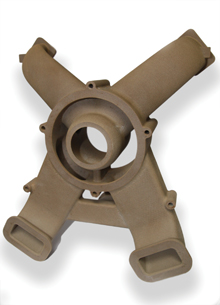 Airduct made from high-temperature PEEK polymer developed for high-temperature laser sintering on EOS systems by Victrex. The part is approximately 10.6 in. end to end. Image courtesy EOS |
Finances, the housing market, health care, and energy issues may keep making the daily headlines, but the business of rapid technologies (RT) continues to move forward. From hands-on demonstrations at the Society of Manufacturing Engineers’ Rapid 2009 event to just-announced business efforts, you’ll see from this overview that collaborating industries are again making progress on a number of fronts.
DE identified seven trends of intriguing RT that warrant close scrutiny: less-expensive systems, high-performance parts manufacturing, new material options, widespread medical and dental applications, innovative support processes and services, renewed activity regarding industry standards and consortiums, and systems to watch.
Whether quietly building on past success or forging ahead by introducing a fresh new approach, these are the products, companies, and rapid technologies to keep track of in the months ahead.
Low-Price Systems
As interest in rapid technologies expands, so does the demand and market opportunity for lower-cost systems. Not just for university-student experiments, these machines create parts for a wide range of industrial uses, yet cost about what we paid not too long ago for an office workstation or laser printer.
Last May, 3D Systems started shipping its desktop V-Flash 3D Printer, based on Film Transfer Imaging technology and priced at $9,900. The system creates high-quality, hard plastic parts up to 9 in. x 7 in. x 8 in.; both the eco-friendly material cartridges, which incorporate certain wear-and-tear parts, and the postprocessing wash fluid can be returned to the V-Flash Recycling center.
Desktop Factory is on the verge of marketing its affordable ($4,995) and easy-to-use desktop manufacturing system. If you’ve followed the remarkably open progress documented on its website, you’ll know it has achieved technical success just as the financial market softened its funding position. Stay tuned.
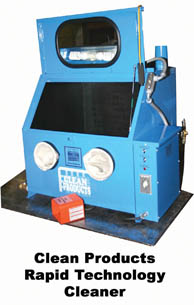 A high-pressure cleaning station for removing support material or excess unsintered material. Users can reach in to clean parts manually, or set parts up on a fixture for automated processing. The station can use both water and solvents. Image courtesy Clean Products |
Dimension, a business group of Stratasys, recently launched its uPrint Personal 3D Printer priced at $14,900. It’s based on fused deposition modeling (FDM) and builds parts from ABSplus plastic, suitable for proof-of-concept parts, functional modeling, marketing tools, and even vacuum-forming molds.
Since rapid processes also include subtractive as well as additive systems, there’s Tormach’s personal CNC (PCNC) 1100 milling machine ($7,480) deserves a mention. Its 1.5 hp motor can cut steel, iron, stainless steels, and titanium. The company, started in 2001, is dedicated to providing the tools for innovation needed by inventors, R&D departments, and small manufacturers.
High-Performance Manufacturing
Whether the term high-performance means faster builds, smoother part surfaces, or out-of-the-ordinary applications, rapid system manufacturers continue to push the limits to meet user demands.
3D Systems has added the sPro 60 SLS Center to its line of selective laser sintering (SLS) systems. The system offers value pricing and the same level of accuracy as the company’s s140/240 models, though with a smaller build volume (15 in. x 13 in. x 18 in.). New CleanSweep IR sensor technology stabilizes the powder temperature reading and cleans the sensor.
Known for its LENS powder-metal repair capabilities, Optomec has also developed its Aerosol Jet system targeted to circuitry. This process takes additive manufacturing into extreme application areas, using nanomaterials to produce fine-feature microelectronics and embedded components without the use of masks or patterns. The Printable Electronic Technology Centre in the UK just purchased an Aerojet to prototype organic thin film transistors.
You probably know Huntsman Advanced Materials for its stereolithography resins, but the company has also developed a complete additive manufacturing system called the Araldite Digitalis Micro Light Build (MLB) system. Using a micromechanical, raster-scan shutter system, the equipment’s design exposes 40,000 pixels at a time, enabling a large area of radiation-curable resin to be exposed in one shot. The system is expected to ship in Q4 2009.
Delivering high-resolution parts without sacrificing build speed (0.5 in. per hour) is a feature of the new Ultra system from Envisiontec. Users can select from ABS- and polypropylene-like materials as well as wax-based types for investment casting. Build volume is 10 in. x 7.5 in. x 8 in. and parts display an extremely smooth finish.
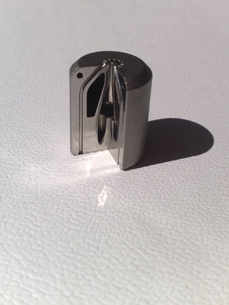 A complex nozzle with internal conformal heating made in laser-melted stainless steel by LayerWise service bureau. It is highly detailed at just about 1 in. tall; similar designs have been manufactured with the same process in Inconel. Image courtesy LayerWise |
EOS, a laser-sintering company, is pushing its systems to handle more exotic materials. It introduced the M 270 in Extended Mode for rapid manufacturing of titanium alloy parts, enabling these to be built much faster and with enhanced quality compared to the first-generation process. In addition, the new EOSINT P 800 builds on the company’s P 370 system with a newly designed processing chamber that is suitable up to 385 degrees C, supporting sintering high-temperature PEEK HP3 material.
New Material Options
Material choices for additive manufacturing continue to expand in both metals and plastics options. User demand for high-temperature operations, biocompatibility, durability, and chemical resistance has been the primary force behind developments.
Stratasys now offers Ultem 9085 lightweight, flame-retardant thermoplastic for its Fortus 400mc and 900mc FDM systems. The raw material, supplied by SABIC Innovative Plastics, is certified for use on commercial aircraft; this is its first application in additive manufacturing. Also new from Stratasys is its SR-30 Fortus support material, with improved solubility and therefore decreased postprocessing time.
EOS added four new materials to its inventory. High-temperature PEEK (polyaryl ether ketone) HP3 polymer achieves tensile strength up to 95 MPa and a tensile modulus of 4,400 MPa. It was developed specifically for high-temperature laser sintering by Victrex, and is biocompatible and highly resistant to fire and chemicals. New EOS metal alloys are the IN625, IN718, and HX, offering a range of high-performance properties for strength, chemical resistance, and operating temperature.
Also targeted to SLS systems is Windform LX powder from CRP Technology. A matte-black polyamide-based material, its new generation glass-fiber reinforcement offers stiffness and high-temperature properties at value pricing.
In the realm of higher strength, 3D Systems now offers VisiJet EX 200 Plastic for the company’s ProJet HD 3000 multijet modeling printer. Likewise, ZCorp added strength to its new zp150 composite material as well as production of more vivid colors and whiter whites. The composite, which works in both the ZPrinter 450 and 650 systems, is water curable—a first for finishing multicolor models.
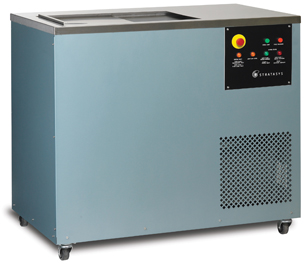 Stratasys says its new Smoothing Station results in FDM plastic parts with the smoothness of an injection-molded part. Image courtesy Stratasys |
More service bureaus are using RenShape SL 7820 from Huntsman. The ABS-like resin offers good dimensional stability even in humid conditions. A curious property is that the resin is white as liquid but turns black upon curing.
DSM SOMOS has also answered the call for more humidity resistant SL material choices with its ProtoGen 18920 product. This gray resin joins the ProtoGen family in displaying different material properties, including tensile strength, based on machine exposure control. And the high-impact Somos DMX-SL 100 (tensile strength 45 MPa) was highlighted at Rapid 2009 when service bureau SICAM pounded SL-100 nails into wood.
Widespread Medical/Dental Apps
Support continues to grow for users of rapid technologies in the dental and medical fields. More than a dozen speakers gave pertinent presentations at Rapid 2009 and the recent Rapid.Tech 2009 fair in Germany hosted a two-day trade conference specifically on dental technology. The latter event targeted both novice and experienced dental technicians.
Solidscape, known for its precise jewelry industry applications, now offers improved performance in the dental industry with the release of its preXacto 3D dental printers. For these systems, and for upgrades to existing systems, users get the benefit of SCP “surface-smoothing technology” and improved material strength with dentaCast wax-up material.
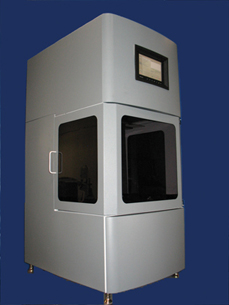 The new Envisiontec Ultra 3D Desktop Printer uses a single material for both build and support structures. Available choices include ABS as well as a polyproplylene-like and wax-based material. Image courtesy Envisiontec |
In the category of RT software, Geomagic announced an import tool that readily brings data into Geomagic software from cone beam computerized tomography (CBCT) systems. The tool works directly with the digital-imaging communication in medicine (DICOM) file format. A new Copings and Frameworks Add-On enables copings and bridge frameworks to be designed directly in Geomagic from intra-oral scans, 3D scans of dental impressions, and CBCT scans.
Innovative Support Processes
DSM Somos has developed a custom version of Materialise Magics software to help SL users create partially hollow parts with variable skin thickness. The application, called TetraShell, supports a cost-effective design solution to rework solid models in such applications as investment casting patterns, reduced-density metal-clad composite structures, and light-weight, large, thick-sectioned parts.
Stratasys now markets a Smoothing Station that improves the surface finish of ABS-based thermoplastic parts made on the company’s FDM systems. The two-step semi-automated process involves placing a part into two successive chambers, one for smoothing and one for curing. To achieve an optional matte or satin finish, users can purchase another unit called a Burnishing Station, used in conjunction with the Smoothing Station.
Aligned with EOS’ goal of establishing e-Manufacturing, the company has added to the Integrated Quality Management System on its plastic laser sintering systems with an Online Laser Power Control module. The unit ensures a more constant flow of energy to the part being built via regular closed-loop control and readjustment of laser energy.
After some additive manufacturing builds, users may need to put the output through manual or automated postprocessing to achieve a finished part. Clean Products manufactures a line of high-pressure parts-washing equipment, typically operating at 800 to 3500 psi to remove support materials or unsintered material. The systems have both manual and automatic functions, use aqueous or solvent solutions, and include filtering systems for reuse.
Service bureau Laser Reproductions has taken a similar step by implementing a new recycling process. The system minimizes the amount of alcohol and other solvents used when cleaning prototypes produced by SLA machines, and produces pure propylene glycol and alcohol suitable for reuse. The company has already seen a cost-savings with a decrease in its purchases of new solvent.
Evolution of Rapid Tech Service Bureaus According to Terry Wohlers of Wohlers Associates, service providers will continue to be an important part of the industry. However, companies have changed, and will continue to change, if they expect to survive and thrive. He explains, “Over the past several years, these companies have lost nearly all of the ‘concept modeling’ business because design and manufacturing firms are now doing it in-house using 3D printers…. Service providers are providing more advanced prototypes for functional testing applications and ones that cannot be produced easily using a low-end system. Materials, finishing, coating, and other processes and offerings set them apart from the ‘quick ‘n dirty’ models that can be done in house.” — PJW |
Renewed Standards/Consortium Activity
Newly formed this year is the Committee F42 on Additive Manufacturing Technologies at ASTM International, originally known as the American Society for Testing and Materials (ASTM). Chairman Brent Stucker, along with Vice-Chairman Carl Dekker, heads this project to establish pertinent independent standards for rapid manufacturing.
A new Direct Manufacturing Research Center started operations in May at the University of Paderborn, Germany. Founding partners include Boeing, EOS, EVonik Industries, and MTT Technologies; Siemens, Stratasys, Stükerjürgen, and JetAviation have also joined as consortium members to develop new processes and systems. The group will initially focus on process improvement and establishing requirements for industry standards.
Two more universities continue their deep involvement with rapid technologies. The United Kingdom’s Loughborough University, last month’s host of the Rapid Manufacturing International Conference, works extensively on quantifying material properties. The University of Louisville, KY, supports direct digital manufacturing with both material testing and guidance on helping supply chain manufacturers qualify for contracts in this field.
Systems to Watch
Voxeljet is a 10-year-old company that provides equipment and services for the direct production of cast and plastic components; their unbound powder is 100 percent recyclable. Watch for them at nine different shows this year.
Sintermask was formed in 2009 yet has more than 10 years of experience. Its Selective Mask Sintering Technology uses infrared light to fuse fine plastic powders; the Sintermask Zorro system is in beta testing and scheduled for a 2010 release.
Solidica, the ultrasonic consolidation company, is quietly expanding the field of smart materials and embedded sensors using additive metal (so far, aluminum) fabrication. It is working on a high-power system and pushing past current limitations on volume and material.
The Air Force Research Laboratory Materials and Manufacturing Directorate continues its involvement with rapid metal manufacturing processes. Interesting results were presented at Rapid 2009 on work incorporating a hybrid approach that integrates direct laser deposition with CNC machining.
Metaltec Innovations, a division of Ex One/ProMetal, now offers fabrication of direct-metal parts as well as casting molds for 3D functional art including building and renovation hardware.
LayerWise offers metal rapid manufacturing services using a variety of laser-melted metal powder systems. Parts can be made from a variety of alloys, including bronze, aluminum, titanium, stainless steel, tool steel, inconel, and cobalt-chromium, and can handle conventional metal postprocessing. The LayerWise service enables clients to develop customized and unique solutions for small and medium runs.
In sum, considering all these topics, if rapid system developers focus on just one area, it seems they’re on a good path for success. The classic combination of listening to customer needs while offering innovations conducive to new applications will help this industry grow despite the difficult economy. A little pressure might be a good thing.
More Info:
3D Systems
Rock Hill, SC
Air Force Research Laboratory, Materials and Manufacturing Directorate
Dayton, OH
ASTM International
West Conshohocken, PA
Boeing
Chicago, IL
Clean Products
Seminole, OK
Desktop Factory
Pasadena, CA
Dimension 3D Printing Group
Eden Prairie, MN
DSM Somos
Elgin, IL
Envisiontec
Ferndale MI
EOS GmbH
Munich, Germany
EVonik Industries AG
Essen, Germany
ExOne/ProMetal Metaltec
Irwin, PA
Geomagic
Research Triangle Park, NC
Huntsman Advanced Materials (Americas)
The Woodlands, TX
JetAviation
Zurick-Airport, Switzerland
Laser Reproductions
Gahanna, OH
LayerWise
Leuven, Belgium
Loughborough University
Leicestershire, UK
Materialise
Leuven, Belgium
MTT Technologies Group
Lubeck, Germany
Objet Geometries, Inc.
Billerica, MA
Optomec
Albuquerque, NM
Printable Electronic Technology Centre
Sedgefield, UK
Quickparts Service
Atlanta, GA
SABIC Innovative Plastics
Pittsfield, MA
Siemens
Munich, Germany
Sintermask Technologies
Lupburg, Germany
Solidica
Ann Arbor, MI
Solidscape
Merrimack, NH
Stratasys
Eden Prairie, MN
Stükerjürgen
Rietberg (Varensell), Germany
Victrex
Thornton Cleveleys, Lancashire, UK
Windform Technology
Modena, Italy
Wohlers Associates
Ft. Collins, CO
ZCorporation
Burlington, MA
Contributing Editor Pamela J. Waterman is an electrical engineer and freelance technical writer based in Arizona. You can contact her about this article via e-mail sent to [email protected].
Subscribe to our FREE magazine, FREE email newsletters or both!
Latest News
About the Author
Pamela Waterman worked as Digital Engineering’s contributing editor for two decades. Contact her via .(JavaScript must be enabled to view this email address).
Follow DE





